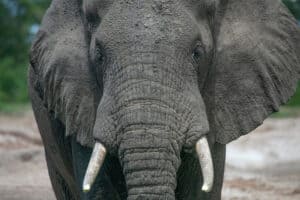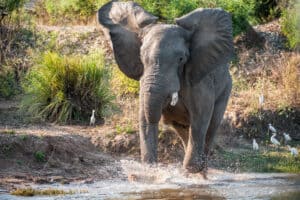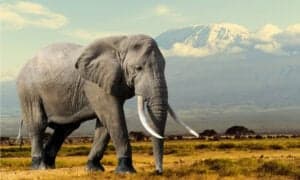Elephants are fascinating creatures that have been studied closely by humans for thousands of years. Today, there are three remaining species of elephants: the African bush elephant, the African forest elephant, and the Asian elephant. These unique species have many amazing qualities and adaptations which have helped them thrive both in their native habitats and in captivity.
You likely already know that elephants are the world’s largest land mammals, but have you heard of any of these other lesser-known elephant facts?

1. An Elephant Molar Tooth is Roughly the Size of a Brick and Can Weigh Anywhere From 4 to 8 Pounds!
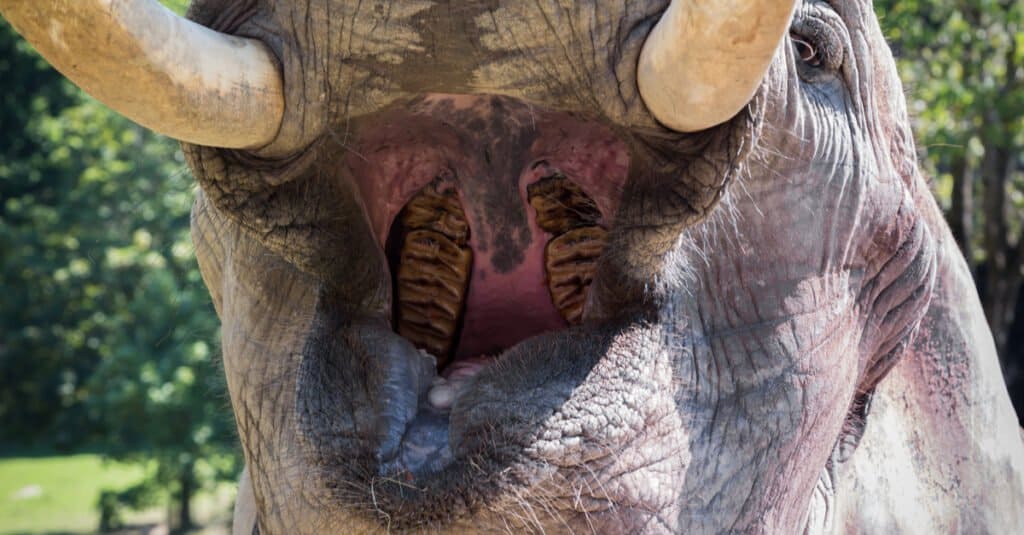
Can you spot the elephant molar teeth? They weigh as much as a brick!
©Eddi_m/Shutterstock.com
Elephants are strictly herbivorous animals, but they still need large teeth to break down the massive amount of plant material they consume each day. They typically have four molars total at any given time, but it is typical for an elephant to go through six sets of molars or more during its lifetime!
These wide, flat molar teeth have ridges on them to help grind up plants like tree bark and branches as efficiently as possible. Interestingly, African and Asian elephants have differently shaped ridges on their molars; African elephants’ molar ridges are diamond-shaped, while those of Asian elephants have a more cylindrical shape.
2. The Oldest Elephant on Record was an Asian Elephant Named Changalloor Dakshayani, who Lived to a Robust 89 Years Old!
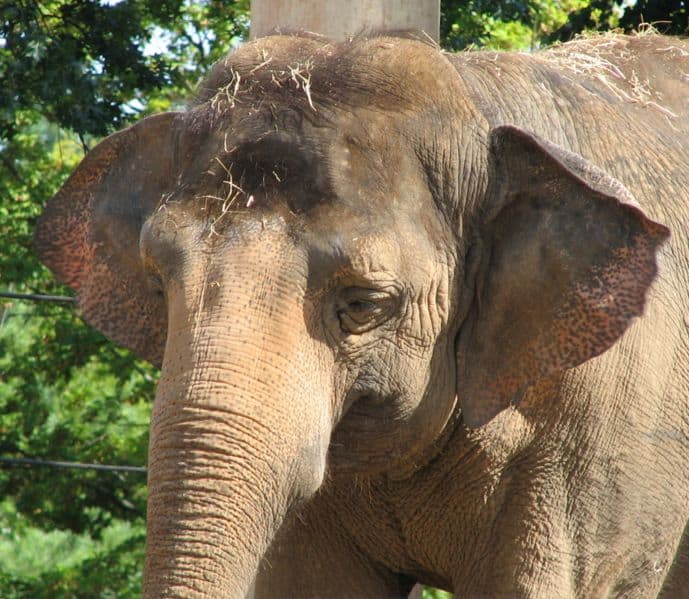
Asian elephants in the wild typically live anywhere from 40 to 50 years.
©Ltshears – Trisha M Shears, Public domain, via Wikimedia Commons – License
Both African and Asian elephants have long lifespans. Asian elephants in the wild typically live anywhere from 40 to 50 years, while African elephants live a bit longer, at around 60 years.
Changalloor Dakshayani was initially bought by India’s Travancore royal family and was donated to the Thiruvarattu Kavu Temple in 1949 when she was 19. She was later transferred to another facility, the Chenkalloor Mahadeva Temple, in the late 1960s.
In 2016, she was officially certified as the oldest elephant in captivity by Kolkata, India’s Univeral Records Forum. She died on February 5th, 2019, at a care facility in Pappanamcode, the capital of Kerala, India, at the ripe, old age of 89.
3. African Elephants Have Larger Ears Than Asian Elephants to Keep Themselves Cool
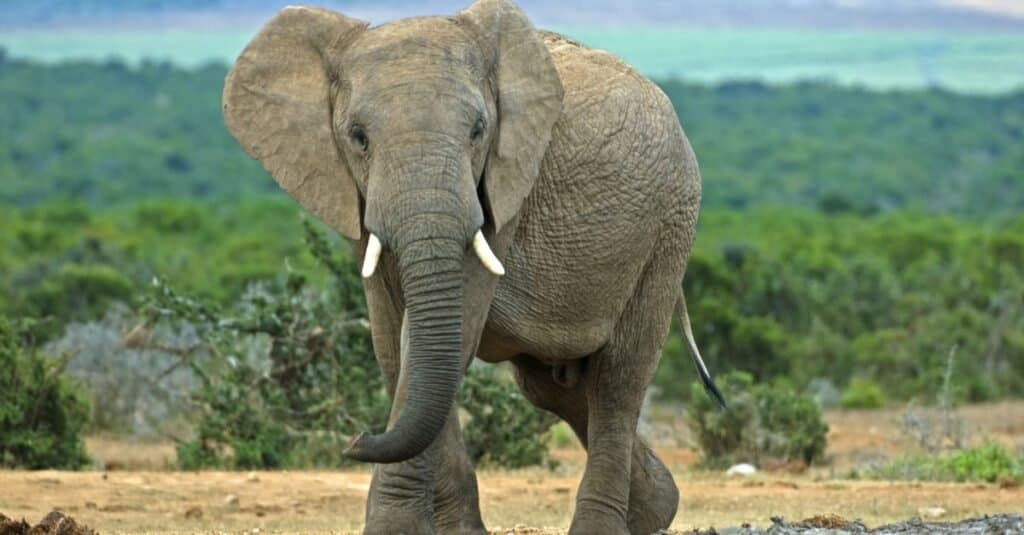
An Elephant challenges the photographer in the wilds of
Africa
. Elephants are the world’s largest land animal, with male African elephants reaching 3m tall and weighing between 4,000 -7,500kg.
©Peter Betts/Shutterstock.com
Just by looking at Asian elephants compared to their African counterparts, it is obvious their ears are far smaller and more rounded in appearance. The main reason for this difference is that they live in vastly different climates.
While Asian elephants live in cooler jungle areas with a lot of plant cover for shade, African elephants live in much hotter, harsher desert-like environments. Over time, this has resulted in African elephants evolving to have much larger ears, which they use sort of as fans to cool their massive bodies off under the brutal African sun.
Additionally, the ears of the African elephant have huge networks of capillaries running through them which work to release excess heat during the elephants’ long, arduous treks through the African savanna.
4. The Only Known Crossbred Offspring of Asian and African Elephants Died After Only 10 Days in Captivity
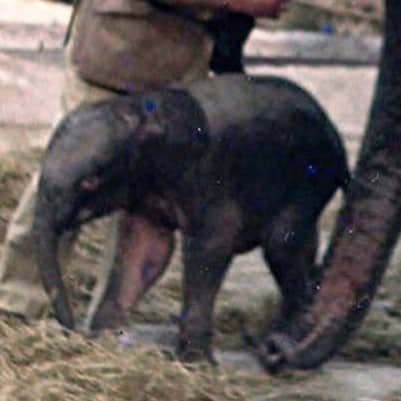
In 1978 at the Chester Zoo in Cheshire, England, a calf named Motty was born to an Asian elephant mother, Sheba, and an African elephant father, Jumbolino.
©IceFloeTurtle, CC BY-SA 4.0 – License
Asian and African elephants never come in contact in the wild, so they have never crossbred naturally. However, this hasn’t stopped humans from trying to breed the two species with each other in captivity.
While there are a few rumored occurrences of Asian/African hybrid elephants being born in various zoos and circuses throughout history, only one has actually been confirmed. In 1978 at the Chester Zoo in Cheshire, England, a calf named Motty was born to an Asian elephant mother, Sheba, and an African elephant father, Jumbolino. Motty was named after the zoo’s founder, George Mottershead.
Sadly, the calf only lived for 10 days before succumbing to an umbilical infection. Today, Motty’s body is preserved at London’s Natural History Museum.
5. Elephants can Recognize Their own Reflection in Mirrors

In 2006, a standard mirror test was done at the Bronx Zoo on three Asian elephants living at the facility.
©Willyam Bradberry/Shutterstock.com
Self-awareness is an extremely rare trait amongst animals, and it has only been consistently demonstrated by and recorded in three species: humans, chimpanzees, and orangutans. However, the “mirror test” has been conducted on many other species, with mixed outcomes.
In more recent years, many other animals such as dolphins, magpies, and even elephants have displayed promising results when subjected to the test. In 2006, a standard mirror test was done at the Bronx Zoo on three Asian elephants living at the facility.
Amazingly, the elephants did not greet their reflection in the same way that they would usually approach other elephants! They were observed to touch the mirror and closely observe themselves, repeating movements like swinging their trunks and moving their heads. It was at this point that the researchers realized the elephants actually understood that they were looking at a reflection of themselves and not another member of their species!
6. An Elephant’s Trunk has Around 40,000 Distinct Muscles!
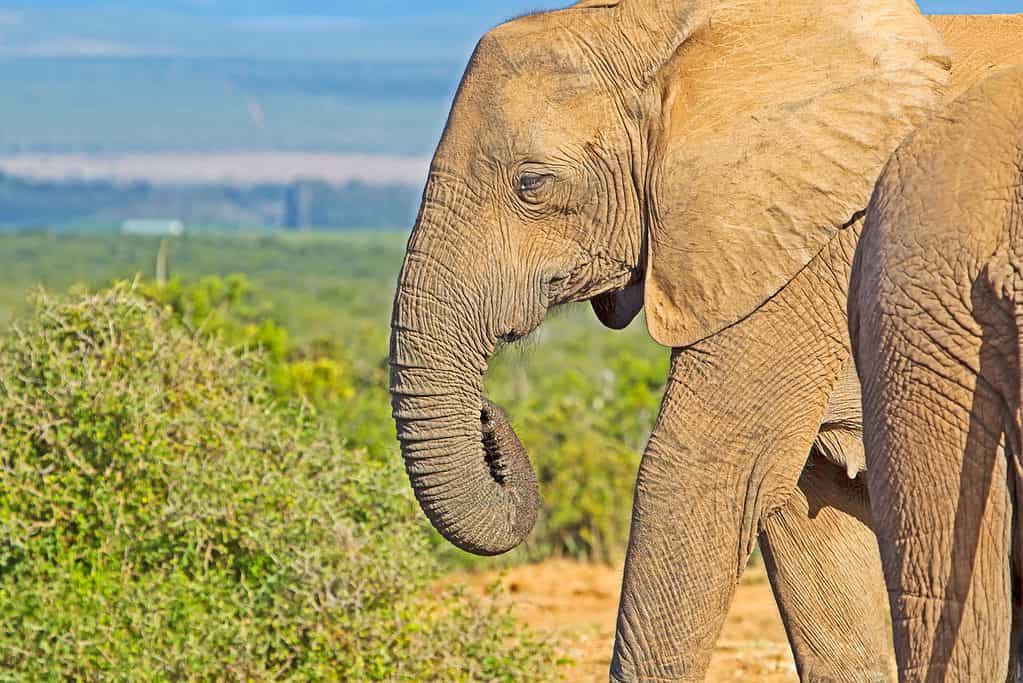
Head photograph of large female elephant in Addo Elephant Park
©iStock.com/geoffsp
By comparison, we humans have around 600 muscles throughout our entire bodies. An elephant’s trunk is extremely powerful and flexible, with those 40,000 muscles divided into even more individual units to give it a wide range of motion and dexterity.
With these 40,000 muscles, an elephant’s trunk is able to pick up objects weighing up to 700 pounds! This is a huge help to them when feeding, as they use their trunks to rip bark clean off of trees and pull entire branches into their mouths with ease.
7. A Baby Elephant Can Weigh Over 250 Pounds at Birth

Baby elephants weigh 250 pounds at birth!
©paula french/Shutterstock.com
It’s no secret that elephants are enormous animals, but did you know just how huge their babies are? A newborn elephant calf usually weighs around 250 pounds, is three feet tall, and can stand up on its own within 30 minutes of being born. This is an amazing feat, considering how heavy they are even at such a young age!
Despite this size and strength at such a young age, though, baby elephants must stay very close to their mothers early on in order to survive. This is because they are nearly blind at birth and have to rely on their other senses, such as sound, touch, and smell to move around.
8. An Elephant’s Tusks are Actually Modified Incisor Teeth
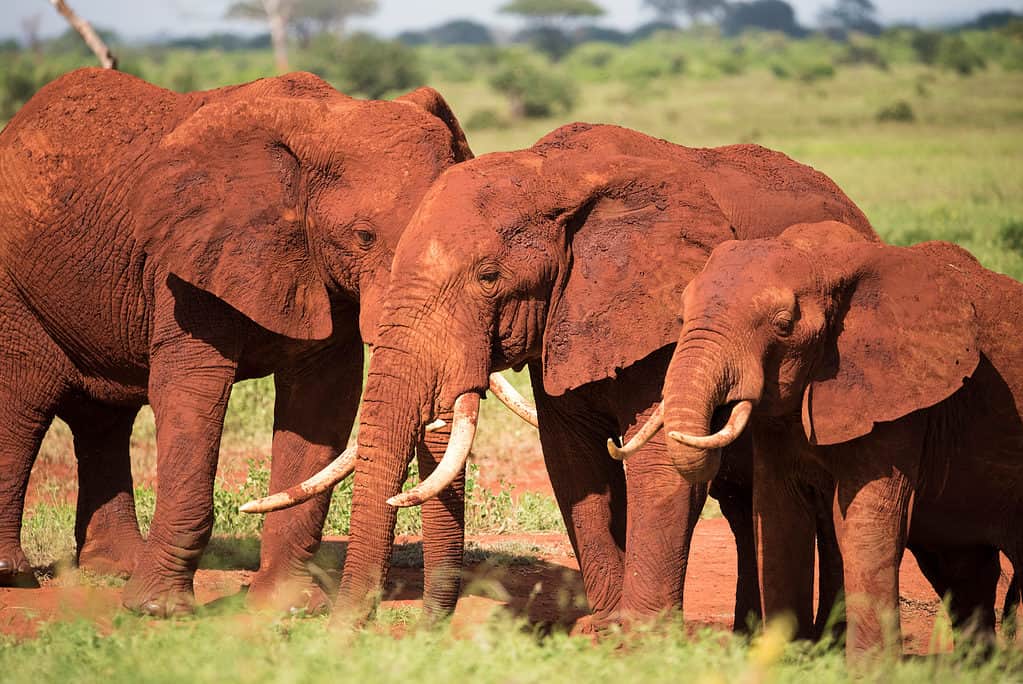
Elephant tusks grow continuously throughout an elephant’s life and are worn down gradually as the animal uses them to eat, dig, and even defend itself.
©Prasanth Aravindakshan/Shutterstock.com
In most species of animals, incisor teeth are primarily used to bite into and tear apart food. An elephant’s tusks are used in a similar way, often tearing into tree bark, branches, and even the ground itself with ease. These tusks grow continuously throughout an elephant’s life and are worn down gradually as the animal uses them to eat, dig, and even defend itself.
In addition, the tusks help to protect the elephant’s tender trunk. They are positioned perfectly on either side of the trunk to shield it from predators and damage from repeated use.
9. Elephants Can’t Jump
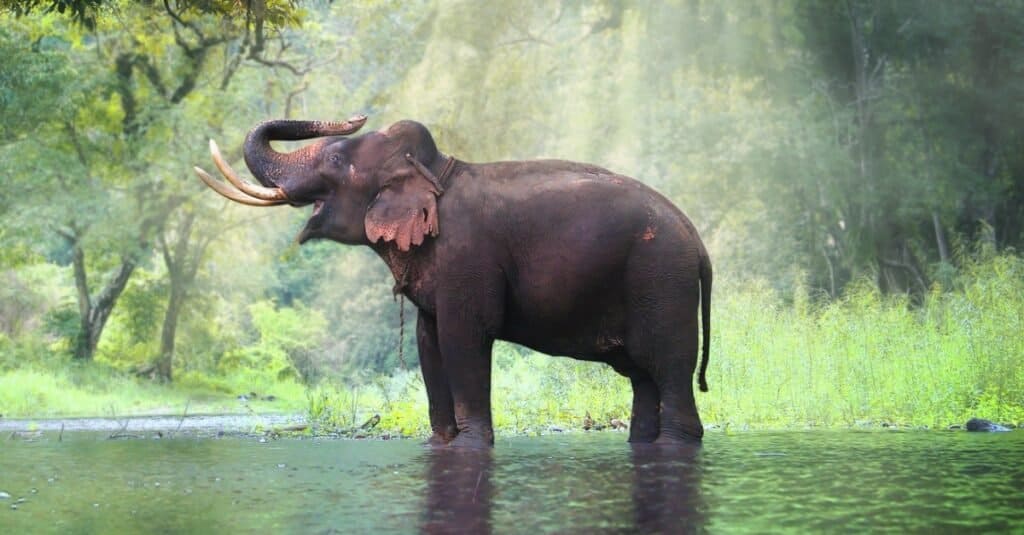
The bones in an elephant’s legs all point downward and lack the flexibility and strength to push themselves off the ground and into the air.
©iStock.com/goodze
We’ve all seen it before – an elephant in a cartoon leaping in fright at the sight of a mouse or other rodent. In reality, though, elephants’ legs aren’t designed for jumping at all.
In addition to being too heavy to lift themselves off the ground, the bones in an elephant’s legs all point downward and lack the flexibility and strength to push themselves off the ground and into the air. Elephants always keep at least one leg on the ground, even while running at speeds of up to 25 mph!
10. Elephants Can Sense Seismic Activity With Their Feet and Trunks
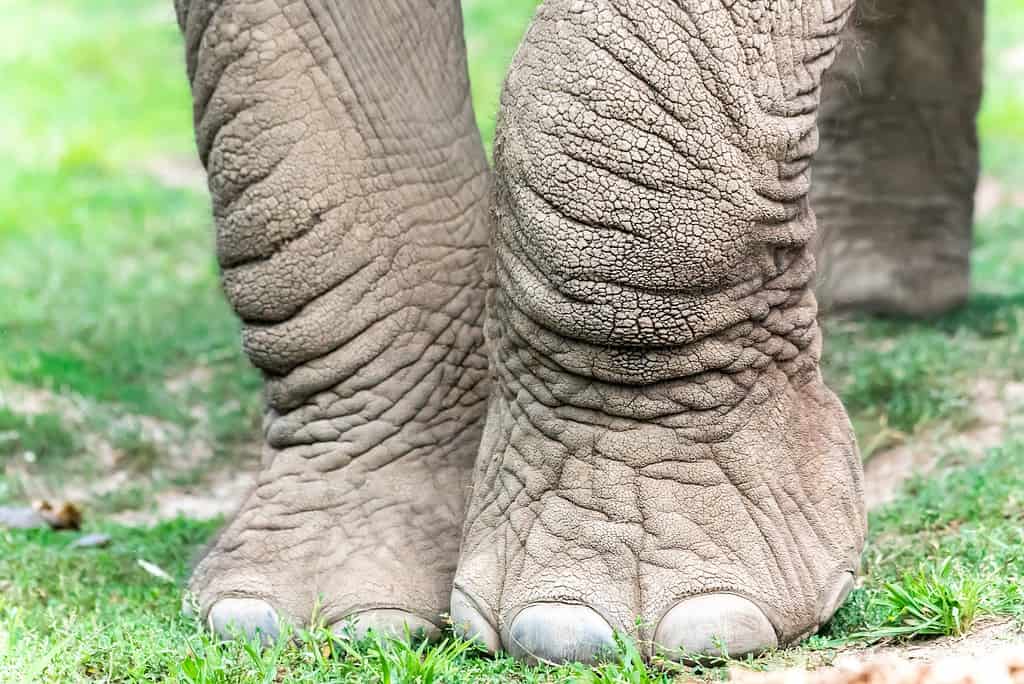
Seismic communication is used by many species to find mates and new territory but it is much more rare amongst large animals like elephants.
©The Speedy Butterfly/Shutterstock.com
Scientists at Stanford University have discovered that elephants use their trunks and feet to pick up on seismic signals given off by other elephants hundreds of feet away!
This behavior is known as seismic communication. Many species of smaller animals use it to find mates, prey, and new territory, but it is much rarer amongst large animals like elephants. It is believed that elephants can even sense oncoming thunderstorms with their trunks and feet and will move toward them to find water!
Summary of 10 Incredible Elephant Facts
| Number | Incredible Elephant Fact |
|---|---|
| 1 | Elephants can recognize their own reflections in mirrors |
| 2 | The oldest elephant lived to 89 years of age |
| 3 | African elephants have larger ears than their Asian counterparts and use them as a cooling mechanism |
| 4 | Only one case of crossbreeding between Asian and African elephants has been recorded |
| 5 | Elephants can recognise their own reflections in mirrors |
| 6 | An elephant’s trunk has 40,000 distinct muscles |
| 7 | Calves may weigh over 250lbs at birth |
| 8 | Their tusks are actually modified incisors |
| 9 | They can’t jump |
| 10 | They can detect seismic activity through their feet and trunks |
The photo featured at the top of this post is © Willyam Bradberry/Shutterstock.com
Thank you for reading! Have some feedback for us? Contact the AZ Animals editorial team.



